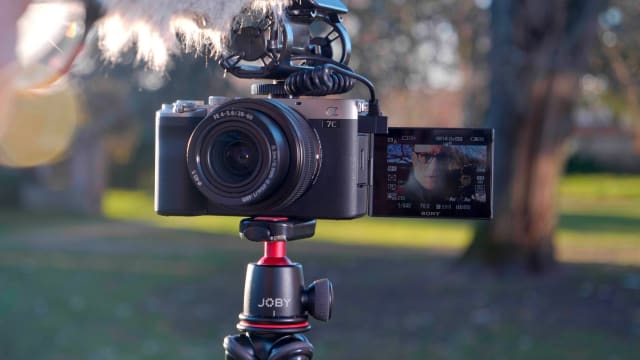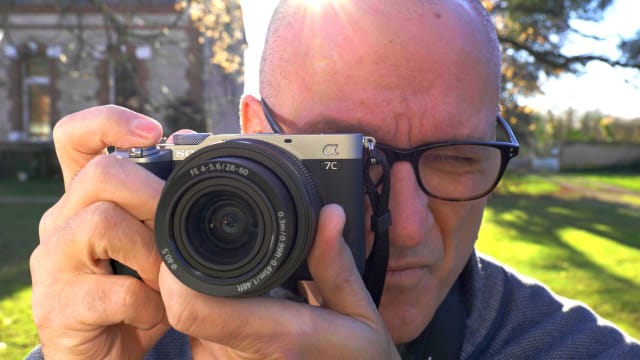Sony A7C review: Smart, small and clumsy
A mini A7 III with better autofocus and worse handling.

With the launch of the A7S III, Sony proved that it still rules the full-frame mirrorless camera market, despite impressive rival products from Canon. On the APS-C side, however, it keeps building the same cameras over and over using recycled parts from past models, with the only real improvements being the autofocus system.
When Sony announced the A7C, I was worried it might be going in that direction with its full-frame cameras, too. The “C” is for compact, and it has a smallish body similar to the A6600, while using the A7 III’s 24-megapixel sensor and other older parts. It also offers A7 III-like specs for 4K video, shooting speeds and more. And much like the A6600, the main improvement is a faster autofocus system with improved subject tracking.
Pros
- Smart and fast autofocus
- Lightweight and small
- Great battery life
- Sharp 4K video
- Decent stabilization
- Flip-out display
Cons
- Mediocre handling
- No 10-bit or 60 fps 4K video
- Subpar viewfinder
- Clunky menus
Summary
Sony’s A7C is a slightly smarter version of the popular full-frame A7 III in the smaller body of the crop-sensor A6600. That means it’s easy to carry around, but has worse handling than the A7 III. It has very similar image quality, shooting speeds and video specs as the A7 III, but uses Sony’s latest AI smarts to improve autofocus tracking. The A7C isn’t quite as capable as recent cameras like the Canon R6, but it’s a bit cheaper. Overall, it’s a good choice for hybrid shooters that lean to the photo side who want a lightweight, modestly priced full-frame camera.
At $1,800, the A7C is $200 cheaper than the A7 III was at launch. Today, however, the A7 III has dropped in price so both cost the same. So the question is, should you get the smaller A7C with improved autofocus, the larger A7 III with more physical dials or another camera altogether? To figure that out, I took it shooting around Paris.
Gallery: Sony A7C mirrorless camera sample images | 31 Photos
Body and handling
Many folks wanted Sony to change the design of their APS-C camera to look like the more classic A7 design, but what we got was the opposite — an A7 camera that looks like the A6600. In fact, the A7C is only slightly larger than the crop-sensor A6600 and is much smaller than any other A7-series camera. It’s the world’s lightest full-frame camera at just 509 grams, compared to 650 grams for the A7 III.
With that tiny body, it was easier to carry around than the A7 III and more discreet for tourist and street photography. Keep in mind that many of Sony’s best full-frame FE lenses are heavy, bar a few like the 30mm f/2.0 model and the new 28-60mm f/3.5-5.6 kit lens. Also, to keep that body so small and light, the A7C lacks a front dial, joystick and other manual controls.
Because of that, I found I had to operate the three main dials with my thumb, which definitely slowed down my shooting. Meanwhile, the lack of a joystick meant I had to use the D-pad to change focus when looking through the viewfinder, an inelegant solution. Some of the other autofocus features help make up for that, though, as I’ll detail shortly.
You can set the focus point with the touchscreen, but it’s not very responsive. And unlike the A7S III, it doesn’t support touch for menus or any other functions. However, it does flip around and fully rotate, which makes the A7C a good vlogging camera.

It didn’t gain the much-improved menu system from the A7S III, either. Instead, Sony retained the confusing menus that I hated so much on the A7 III. With all the extra scrolling and fumbling required to find settings, you’ll want to set up the custom menus and buttons before using this camera.
Another issue that will annoy hybrid shooters is the lack of separation between photo and video modes. On other new cameras like the Panasonic S5, the Canon R6 and Sony’s A7C III, switching will change all the appropriate settings. The A7C keeps everything the same, so you’ll need to use a custom mode to keep the still and movie modes firewalled from each other.
The electronic viewfinder isn’t a strong point, either. Without a center hump like other A7 cameras, the EVF is pushed to the left corner. As a result, it’s small and lacks a decent-sized eyecup. The resolution is also not great at 2.36 million dots, compared to the 3.69 million dot EVF on Fujifilm’s cheaper X-T4, for example. It does improve on the A7 III’s EVF by doubling the refresh rate to 120 Hz, but because of the small size and wide magnification, it’s not as pleasant to use.
Sony no doubt made these tradeoffs to keep the price and size of the A7C down, which is fair enough. Luckily, there are no compromises on the battery, which is the larger NP-FZ1000 found on the A7S III and A7R IV. It can go an impressive 680 shots on a charge, pushing DSLR territory, compared to 610 for the A7 III. I also got a respectable hour and 55 minutes of 4K video shooting on a charge.
Lastly, it has just a single card slot, which isn’t ideal for pro photographers who need a backup. However, it’s located on the side and not in the battery compartment like on the A6600, thank God, and supports fast UHS II card speeds.
Performance

Since they share the same sensor, Bionz X image processor and 693-point phase-detect AF system, it’s no surprise that the A7C performs much like the A7 III. To wit, it has similar 10 fps burst speeds, image quality and low-light sensitivity. However, the A7C has a few tweaks related to the buffer, autofocus performance and image stabilization.
















